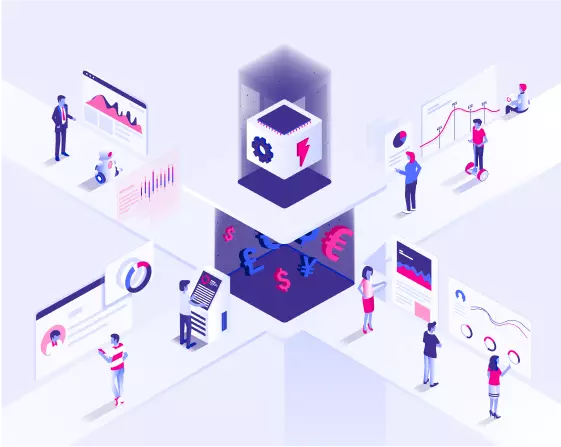Products
Translate business goals into solutions, streamline processes, improve operational efficiency, and ensure continuous improvement
Solutions that go beyond software
All products and solutions we design and develop aim to drive the digital transformation across client organisations by working together to integrate and optimise software, services, and platforms
Addressed Industries & Departments
Customer Service Organisations
Shared Service Centers
Front- & Backoffice Service Providers
Legal & Compliance Departments
IT Departments
CX Organisations
product
Surveys
& Feedback
#amazingproduct
product
Interaction
Quality & Compliance
#amazingproduct
product
Case & Root
Cause Analysis
#amazingproduct
product
Insights, Dashboards
& Reports
#amazingproduct
product
ONE CX Quality Management Solution
#amazingproduct
product
ONE
Platform
#amazingproduct
product
Surveys
& Feedback
#amazingproduct
product
Interaction
Quality & Compliance
#amazingproduct
product
Case & Root
Cause Analysis
#amazingproduct
product
Insights, Dashboards
& Reports
#amazingproduct
product
ONE CX Quality Management Solution
#amazingproduct
product
ONE
Platform
#amazingproduct
#whatwedo
Services
We are here to accompany you along your way
Our expert consultants are ready to help you accelerate organizational change with valuable input on a variety of topics, from service strategy to continuous improvement
#whatwedo
People
Extend your team effortlessly
Complete your mid- and long-term projects faster, more efficiently and with less risk: Intersoft supports you in covering a large variety of roles and responsibilities
#whatwedo

Value proposition
Who we are and
what speaks for us


Agile
Approach
We are thorough and respect process improvement methodologies, but also agile when it comes to our solutions and services.
Fast delivery and
quality services
We accept the fact that sometimes solutions are needed yesterday. Therefore we get things right the first time and have your back day and night.
Business
Expertise
While our experience has taught us a great deal, it’s our people who will accompany you along your business journey and bring in the know-how that will help you realize your goals.
Managed
Services
We know every successful solution needs ongoing adjustments to keep it alinged to ever changing business requirements.
We are happy to take care of this for you.
Scalable
Solutions
We build solutions that are easily integrated with your existing systems and can grow with you.
Because we know how costly and difficult it otherwise can get.
Competence and
Understanding
We know. We can. We want.
More than that, we believe a good relationship is built on trust, understanding and permanent communication.
Your CX strategy
We make sure IT happens
people | services | solutionsResources and articles
What are the best employee engagement strategies to follow?
11 January 2022
Introduction
While the majority of businesses, if not all, want their employees to be happy, they still put profitability first over employee happiness. However, there is increasing evidence showing that there is a direct link between employee engagement and higher profitability. In fact, businesses with happy and therefore engaged employees outperform the competition by 20%.
In today’s article, we’re going to explain what talent management is, what drives employee engagement, as well as share with you some of the best employee engagement strategies to ensure your workforce is happy. Let’s start off with a talent management definition.
What is talent engagement?
Talent engagement is about attracting candidates with the right skills and attitude to your organization, and ensuring that both your current and future employees engage, understand, and can relate to your business goals and principles. In order to measure employee engagement, organizations turn to employee engagement rate, i.e., the perceived commitment an employee displays towards an organization. There are several metrics that can be applied to measure the employee engagement rate, for instance, NPS, absenteeism, and turnover rates.
Now that you know what talent engagement is, let’s take a look at the factors which impact it.
What drives engagement?
There are many engagement drivers that decide upon whether your employees are satisfied and engaged at work. We will focus on the three most common ones.
Management/Leadership
According to the 2019 Employee Engagement Trends Report by Quantum Workplace, the second most important engagement driver is trusting senior leadership. Frequently, one of the reasons why employees are disengaged is the lack of trust in management. As it’s the management and C-suite that set the direction in which the organization is supposed to go, if employees don’t trust senior leadership, they won’t commit to fulfilling business goals.
Meaningful work
Employees want to feel their work matters. Deloitte revealed that 42% of the respondents surveyed sought new job opportunities because they couldn’t make good use of their skills and abilities in their current workplace. What’s more, those who planned to change jobs mentioned lack of career progression (37%) and their job not being challenging enough (27%) as the two main factors impacting their career decisions. Employees, especially the most skilled ones, want to feel their work contributes to a greater goal, and that they can put their skills to good use. Without this conviction, they won’t be able to fully commit to work.
Liking your co-workers
We spend a lot of time at work, so it’s not surprising that one of the engagement drivers is the relationship we have with our co-workers. In a survey conducted by SHRM, 41% of employees admitted that it was a very important factor that impacts their job satisfaction. A good relationship with your fellow employees leads to loyalty and fellowship. They enjoy spending time together and don’t want to disappoint each other, which makes them work harder.
What are the reasons for employee disengagement?
Gallup has found that in 2019 the employee engagement rate has reached 35%, which is the record high since they started measuring it in 2000. Yet still, 13% of the American workforce remains actively disengaged, and for this reason, it’s worth looking at the main employee disengagement factors. However, before we do so, let’s explain what “actively disengaged” indicates. These are the employees who act to the company’s detriment. For example, they monopolize their manager’s time, tend to have more job accidents, take a lot of sick leave, and display a higher quit rate.
What causes employees to become actively disengaged?
Poor leadership
Earlier in this post, we mentioned the importance of management for employee engagement rate. Poor leadership negatively impacts employee commitment – only 42% of workers trust their boss. This, to an extent, explains why there are so many disengaged employees.
Lack of feedback
Employees like to feel their work is valued, and there is no better way to show appreciation than through regular feedback. Those who don’t receive feedback tend to work less hard – 96% of employees say they want to hear it regularly. It’s important to note that feedbacking should go beyond annual performance reviews as “there's no way to get better at something you only hear about once a year” - Daniel Pink.
Lack of career growth opportunities
Lack of career growth opportunities is one of the most common reasons for switching jobs. On the contrary, good career growth prospects is one of the most important factors for staying with the current employer. This criterion plays a particularly crucial role if the majority of your workforce are Millennials – since 87% of them admit that career development is very important to them.
Dissatisfaction with benefits and pay
In a study on job switching conducted by Indeed, over half of respondents reported they changed employers primarily because they felt dissatisfied with their salaries. Among other factors, they also mentioned inflexible schedules and long commutes, which contrasted with the offers they were presented with by their future employers.
Not having access to the right resources
Employees feel frustrated if they lack access to the right tools and resources. If they feel that it’s virtually impossible to fulfill standards set by their managers, they will lose motivation and feel detached from your organization’s goals.
The best employee engagement strategies you can use
Let us now review several methods that you can apply to boost your employee engagement.
Strategy 1: Survey your employees (and candidates)
Employees who have a way of providing feedback to management report that they are 4.6 times as likely to perform at their best. Surveys are one very effective way of giving them the chance to voice their opinions.
Using surveys, you can collect feedback regarding any policies, processes, or faulty workflows that may stand behind employee disengagement or that might cause them frustration. They are also a great way of continuously collecting improvement suggestions. For example, if your company is considering introducing a new service or internal process, you can quickly run a survey to collect input from your employees and evaluate the idea.
Surveys can also be used to collect feedback from your job applicants to boost the candidate experience and attract better talent.
Here are some types of surveys we suggest you include in your talent engagement strategy:
- Employee satisfaction survey (for instance, the previously-mentioned eNPS)
- Training needs’ survey
- Training evaluation survey
- Recruitment feedback survey
Strategy 2: Conduct quality audits
Quality monitoring might not be the first thing that comes to mind as far as employee engagement tactics are concerned, however, it’s another important engagement driver. It serves not only as a way to evaluate the quality of work but also to help your employees feel more fulfilled in their role.
Use a Quality Monitoring solution to conduct employee performance reviews and see whether there’s anything you can do to help them be better at their job. By incorporating it into your business, you will reveal improvement potential on an employee and business level, which translates to people receiving support, coaching, and training to further develop their skills. As a result, your employees will feel heard, which will improve morale and boost their motivation.
Strategy 3: Conduct regular meetings with employees
Scheduling regular meetings between the employee and HR (or their direct managers) will give you the opportunity to track employee satisfaction over time. It will also serve as a way to find out if there’s anything your company can do better and include in the employee engagement strategy.
Apart from regular checkups, you should also make sure to schedule meetings whenever you see a drop in engagement or receive a poor employer evaluation in a survey. Certain solutions, such as Intersoft, will even help you predict employee flight risk based on the employee data available to management, such as their communication with clients or a drop in metrics (which we discuss further in the next point).
Strategy 4: Monitor your employees’ performance over time
Last, but not least, it’s imperative that you use a tool that will help you track and visualize employee performance. If you see a drop in any metrics, for instance, lower scores in customer service evaluation surveys, a longer-than-average time to resolve tickets, or a decrease in the volume of customer calls, this can point to two occurrences:
- A per-employee issue – for example, an employee feeling burnout or a drop in motivation due to the lack of a career path
- A cross-team issue (for instance, a newly implemented process turned out to be counterproductive and needs to be fixed ASAP)
Insights & Reports tools will be a great supplement to your quality monitoring efforts, as no serious issue will go unnoticed.
Summary
Employee engagement is a factor deeply connected to any organization’s success. Without the right approach towards talent management, your employees will feel unmotivated, detached from your team, and might eventually seek new employment. In order to ensure that these risks don’t come to fruition, you must have an employee engagement strategy in place. Use a solution like Intersoft to track employee engagement rates, collect feedback from your employees, and to support them in their goals.
If you’d like to learn more about how to create your talent engagement strategy, don’t hesitate to reach out!
Related Articles
 All Categories
All Categories
 Survey Experience
Survey Experience
 Business Intelligence
Business Intelligence
 Business Process Management
Business Process Management
 Quality Improvement
Quality Improvement
How to create great CX with customer analytics
14 December 2021
How to create a quality framework and why it matters
9 November 2021
Contact monitoring and employee development done right
11 September 2021
Do we feel overwhelmed by the large number of tools we work with?
24 August 2021
The missing insight in your survey design
23 June 2021
Customer survey response rates
08 June 2021
References
Selected References
Outstanding solutions and services make these clients choose to work with us in longterm partnerships.
#ourpartners

























